Abstract
In most of the literature on emergency medical service (EMS) system design and analysis, arrivals of EMS calls are assumed to follow Poisson process. However, it is not uncommon for real-world EMS systems to experience batch arrivals of EMS requests, where a single call involves more than one patient. Properly capturing such batch arrivals is needed to enhance the quality of analyses, thereby improving the fidelity of a resulting system design. This paper proposes a spatio-temporal demand model that incorporates batch arrivals of EMS calls. Specifically, we construct a spatio-temporal compound Poisson process which consists of a call arrival model and call size model. We build our call arrival model by combining two models available in the existing EMS demand modeling literature—artificial neural network and spatio-temporal Gaussian mixture model. For the call size model, we develop a k-inflated mixture regression model. This model reflects the characteristics of EMS call arrivals that most calls involve one patient while some calls involve multiple patients. The utility of the proposed EMS demand model is illustrated by a probabilistic ambulance location model, where we show ignoring batch arrivals leads to overestimation of ambulance availability.












Similar content being viewed by others
Notes
We process \(\varvec{X}_t\) to a suitable form for each models. For example, we use artificial neural network (ANN) to model \(\varLambda _t\) and \(\varvec{X}_t\) is processed to three discrete variables; month-of-year, day-of-week, hour-of-day.
We used the EMS call data from the city of Daejeon, Korea, for the period of January 1st, 2011 to December 31st, 2012, and test each model for their forecasting accuracy(Lee and Lee 2016). ANN showed better performance than the other two methods in forecasting length of 1 hour, 1 day, 3 days, 1 week. Results from these experiments can be supplied upon request.
\(\varvec{\omega }_t = \left( \omega _{1}(\varvec{X}_t), ..., \omega _{C}(\varvec{X}_t)\right)\).
Equations for implementing an EM algorithm for geometric and negative binomial distribution are provided in “Appendix A”.
For the GA algorithm, we set the population size at 2000, elite population 5%, crossover probability to be 60%, and mutation probability to be 5%.
\(e = |\)loss probability estimated from hypercube queuing - loss probability (fraction of lost calls) measured in simulation|.
References
Alanis R, Ingolfsson A, Kolfal B (2013) A Markov chain model for an EMS system with repositioning. Prod Oper Manag 22(1):216–231
Azeez Jazeem, Aravindhar D John (2015) Hybrid approach to crime prediction using deep learning. In: 2015 International conference on advances in computing, communications and informatics (ICACCI), pp. 1701–1710. IEEE
Baker JR, Fitzpatrick KE (1986) Determination of an optimal forecast model for ambulance demand using goal programming. J Oper Res Soc 37(11):1047–1059
Bélanger V, Ruiz A, Soriano P (2019) Recent optimization models and trends in location, relocation, and dispatching of emergency medical vehicles. Eur J Oper Res 272(1):1–23
Bishop CM (2006) Pattern recognition and machine learning. Springer, Berlin
Brotcorne L, Laporte G, Semet F (2003) Ambulance location and relocation models. Eur J Oper Res 147(3):451–463
Budge S, Ingolfsson A, Erkut E (2009) Approximating vehicle dispatch probabilities for emergency service systems with location-specific service times and multiple units per location. Oper Res 57(1):251–255
Channouf N, LEcuyer P, Ingolfsson A, Avramidis AN (2007) The application of forecasting techniques to modeling emergency medical system calls in Calgary, Alberta. Health Care Manag Sci 10(1):25–45
Chen AY, Lu T-Y, Ma MH-M, Sun W-Z (2016) Demand forecast using data analytics for the pre-allocation of ambulances. IEEE J Biomed Health Inf 20(4):1178–1187
Finkelman MD, Green JG, Gruber MJ, Zaslavsky AM (2011) A zero-and k-inflated mixture model for health questionnaire data. Stat Med 30(9):1028–1043
Freitas AV, Afreixo V, Cruz SE (2013) Mixture models of geometric distributions in genomic analysis of inter-nucleotide distances. Stat Optim Inf Comput 1(1):8–28
Fritsch Stefan, Guenther Frauke (2016) Package neuralnet. The Comprehensive R Archive Network
Fujiwara O, Makjamroen T, Gupta KK (1987) Ambulance deployment analysis: a case study of Bangkok. Eur J Oper Res 31(1):9–18
Furman E (2007) On the convolution of the negative binomial random variables. Stat Probabl Lett 77(2):169–172
Gendreau M, Laporte G, Semet F (2006) The maximal expected coverage relocation problem for emergency vehicles. J Oper Res Soc 57(1):22–28
Goldberg J, Dietrich R, Chen JM, Mitwasi MG, Valenzuela T, Criss E (1990) Validating and applying a model for locating emergency medical vehicles in Tuczon, AZ. Eur J Oper Res 49(3):308–324
Goldberg JB (2004) Operations research models for the deployment of emergency services vehicles. EMS Manag J 1(1):20–39
Jarvis JP (1985) Approximating the equilibrium behavior of multi-server loss systems. Manage Sci 31(2):235–239
Jin LH, Taesik L (2016) Comparison of spatio-temporal emergency medical demand forecasting model for emergency medical system operation planning. In: Proceedings of the Korea Institute of Industrial Engineers fall conference, pp. 1864–1882
Kamenetzky RD, Shuman LJ, Wolfe H (1982) Estimating need and demand for prehospital care. Oper Res 30(6):1148–1167
Kang H-W, Kang H-B (2017) Prediction of crime occurrence from multi-modal data using deep learning. PLoS ONE 12(4):e0176244
Larson RC (1974) A hypercube queuing model for facility location and redistricting in urban emergency services. Comput Oper Res 1(1):67–95
Larson RC (1975) Approximating the performance of urban emergency service systems. Oper Res 23(5):845–868
Matteson DS, McLean MW, Woodard DB, Henderson SG et al (2011) Forecasting emergency medical service call arrival rates. Ann Appl Stati 5(2B):1379–1406
McCarthy ML, Zeger SL, Ding R, Aronsky D, Hoot NR, Kelen GD (2008) The challenge of predicting demand for emergency department services. Acad Emerg Med 15(4):337–346
Najafabadi ATP, MohammadPour S (2017) A k-inflated negative binomial mixture regression model: application to rate–making systems. Asia-Pacific J Risk Insur 12(2). https://doi.org/10.1515/apjri-2017-0014
Nakaya T, Yano K (2010) Visualising crime clusters in a space-time cube: an exploratory data-analysis approach using space-time kernel density estimation and scan statistics. Trans GIS 14(3):223–239
Naoum-Sawaya J, Elhedhli S (2013) A stochastic optimization model for real-time ambulance redeployment. Comput Oper Res 40(8):1972–1978
Papier F, Thonemann UW (2008) Queuing models for sizing and structuring rental fleets. Transp Sci 42(3):302–317
Peleg K, Pliskin JS (2004) A geographic information system simulation model of ems: reducing ambulance response time. Am J Emerg Med 22(3):164–170
Puig P, Valero J (2006) Count data distributions: some characterizations with applications. J Am Stat Assoc 101(473):332–340
Repede JF, Bernardo JJ (1994) Developing and validating a decision support system for locating emergency medical vehicles in Louisville, Kentucky. Eur J Oper Res 75(3):567–581
Sarabia JM, Prieto F, Trueba C (2012) The n-fold convolution of a finite mixture of densities. Appl Math Comput 218(19):9992–9996
Schmid V (2012) Solving the dynamic ambulance relocation and dispatching problem using approximate dynamic programming. Eur J Oper Res 219(3):611–621
Setzler H, Saydam C, Park S (2009) Ems call volume predictions: a comparative study. Comput Oper Res 36(6):1843–1851
Sung I, Lee T (2018) Scenario-based approach for the ambulance location problem with stochastic call arrivals under a dispatching policy. Flex Serv Manuf J 30(1–2):153–170
Taddy MA, Kottas A et al (2012) Mixture modeling for marked Poisson processes. Bayesian Anal 7(2):335–362
Vile JL, Gillard JW, Harper PR, Knight VA (2012) Predicting ambulance demand using singular spectrum analysis. J Oper Res Soc 63(11):1556–1565
Wei LSS, Sian NY, Rajagopal LM, Yng NY, Hock OME (2016) Ambulance deployment under demand uncertainty. J Adv Manag Sci 4(3):187–194
Winters PR (1960) Forecasting sales by exponentially weighted moving averages. Manage Sci 6(3):324–342
Wolfe P (1971) Convergence conditions for ascent methods. ii: Some corrections. SIAM review 13(2):185–188
Zhou Zhengyi, Matteson David S (2016) Temporal and spatio-temporal models for ambulance demand. Healthcare Analytics: From Data to Knowledge to Healthcare Improvement, pp. 389–412
Zhou Z, Matteson DS, Woodard DB, Henderson SG, Micheas AC (2015) A spatio-temporal point process model for ambulance demand. J Am Stat Assoc 110(509):6–15
Funding
This research was supported by the “Decision Models in Behavioral Operations Research” through the National Research Foundation of Korea(NRF), funded by the Ministry of Science and ICT (2019-R1A2C108830212).
Author information
Authors and Affiliations
Contributions
All authors contributed to the study conception and design. Material preparation, data collection and analysis were performed by HL and TL. The first draft of the manuscript was written by HL and all authors commented on previous versions of the manuscript. All authors read and approved the final manuscript.
Corresponding author
Additional information
Publisher's Note
Springer Nature remains neutral with regard to jurisdictional claims in published maps and institutional affiliations.
Appendices
Appendix A: First and second order derivatives for negative binomial distribution and geometric distribution
Let us denote the two parameters of a negative binomial distribution by \(\xi\) (number of failures) and \(\delta\) (probability of success in a Bernoulli trial). Then, the first and second order derivatives of \(Q_1\) and \(Q_2\) for the negative binomial distribution are
where \(\alpha _{ml}\) indicate the coefficient for \(l^{th}\) variables in \(V_{i,t}\), \(\varGamma\) denotes gamma function, and \(\psi\) represent digamma function \(\psi (x) = \frac{d}{dx}ln(\varGamma (x))\).
For geometric distribution, we use \(\zeta\) to denote its parameter – success probability in Bernoulli trials. Its first and second derivatives are
Appendix B: Batch arrival hypercube queuing approximation
In this section, we briefly introduce the hypercube queuing model (Larson 1975; Jarvis 1985; Budge et al. 2009), and explain how we modify the model to incorporate batch arrivals. Consider a network of N servers that serve D demand nodes. For each demand node, servers are ordered by their preference rank by the node. Let \(g_{ji}\) denote a dispatching probability of server j to demand node i when i is a \(k^{th}\) preferred server. Then, \(g_{ji}\) is approximated as,
In Equation (B.1), \(\rho\) represents the system-wise busy fraction, \(\rho _j\) denotes the busy fraction of server j, and \(a_{il}\) denotes the index of \(l^{th}\) preferred server for demand node i. The system-wise busy fraction \(\rho\) is determined as \(\lambda \tau / N\), where \(\lambda\) is the system-wise arrival rate and \(\tau\) is the average service time. The essence of this approximation is the correction factor \(Q(N,\rho ,k)\). \(Q(N,\rho ,k)\) is introduced in Equation (B.1) in order to compensate for the errors due to the dependence of servers in the queuing network. Larson (1975) proposed \(Q(N,\rho ,k)\) for the hypercube queue as shown below:
where \(P_0\) and \(P_N\) denote the idle probability and loss probability of an M/M/N/N queue. Since the probability that u servers are busy, \(P_u\), in an M/M/N/N queue is \(P_u = \frac{(N\rho )^u}{u!}*P_0\), we can rewrite Equation B.2 as
To account for batch arrivals, we use \(P_u\) from \(M^X/G/N/N\) queue (Papier and Thonemann 2008), instead of from M/M/N/N queue:
where \(\varPhi ^{(a)}\) denotes \(a^{\text {th}}\) convolution of batch size distribution \(\varPhi\). That is, \(\varPhi ^{(a)}(u)\) represents the probability that the sum of a batches sampled from distribution \(\varPhi\) is u. Then, a generalized correction factor \(Q^*(N,\rho ,k)\) is
It is easy to show that the generalized correction factor reduces to the single arrival correction factor, Equation (B.2).
In Equation (B.5), the most challenging part is the calculation of \(\varPhi ^{(a)}(u)\). Note that we use a mixture model for our call size model, i.e., \(\varPhi (u)=\sum _{m\in {1,\ldots ,M}}\pi _m\phi _m(u)\), and based on the results from Sarabia et al. (2012), we derive \(n^{\text {th}}\) convolution of the mixture distribution as
where \(C_n\) is a set of combinations for n batches’ mixture membership.
In our model, we use a geometric distribution for \(\phi _m\). Since the sum of random variables from geometric distribution follows a negative binomial distribution, Equation (B.6) becomes,
Furman (2007) provides an approximation to evaluate the convolution of a negative binomial distribution. (refer to Theorem 2. of Furman (2007)).
Rights and permissions
About this article
Cite this article
Lee, H., Lee, T. Demand modelling for emergency medical service system with multiple casualties cases: k-inflated mixture regression model. Flex Serv Manuf J 33, 1090–1115 (2021). https://doi.org/10.1007/s10696-020-09402-7
Accepted:
Published:
Issue Date:
DOI: https://doi.org/10.1007/s10696-020-09402-7




